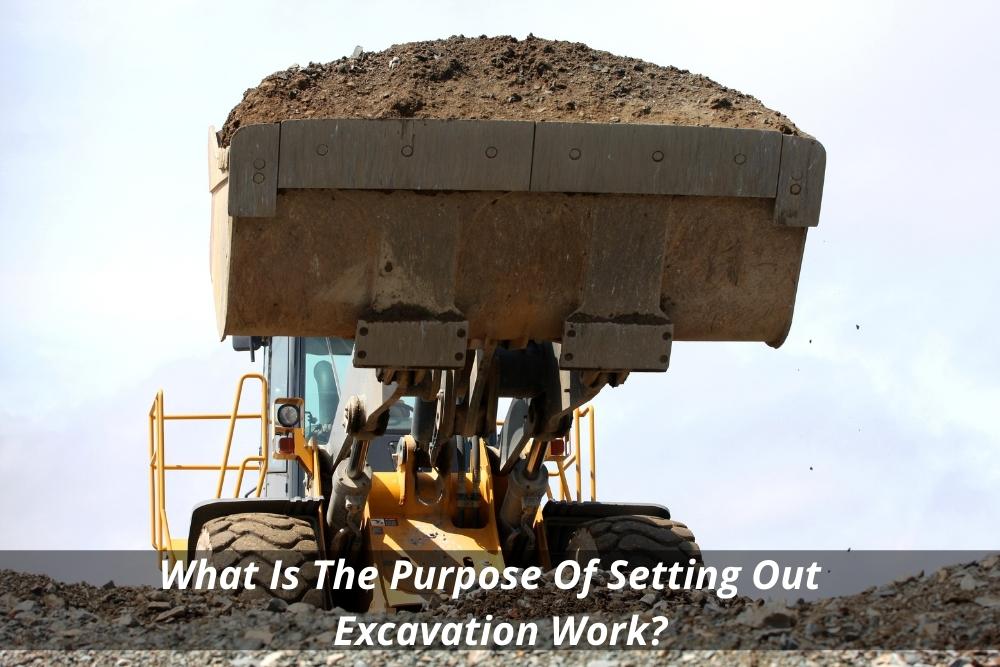You’ve probably heard of the term ‘excavation’ before. This refers to digging down into the ground to uncover buried objects or materials. Excavation Newcastle is usually hired by companies who want to dig holes in order to build new roads, buildings, etc.
Excavation is often necessary for construction projects because it allows workers to see what lies beneath the surface. In some cases, excavations also allow us to discover things that would otherwise remain hidden from view. For example, archaeologists have found ancient artifacts and fossils during excavations.
Excavation is important for several reasons. First, it helps prevent accidents such as cave-ins. Second, it provides information about the history of the area.
Third, it allows us to determine whether something dangerous is present underground. Finally, excavation is sometimes required to locate utilities such as pipes and cables.
Setting Out Excavation Work
We call this process “setting out” excavation work and we use a different set of tools than those used with other types of excavation.
The most common tool is called an auger. It’s basically like a drill with a long handle. A trencher is another commonly used tool. Trenchers are similar to backhoes but much smaller.
Once our job starts, we’ll need to establish the boundaries of the excavation. We’ll do so using stakes, which can be metal posts driven into the ground.
If you’re working on private property, your owner will likely provide these stakes. Otherwise, you may need to buy them at a hardware store. Once the stakes are established, we mark off each individual square foot within the boundary lines.
Next, we’ll lay out the path for the actual excavation. This part requires experience. You don’t just walk up to a pile of dirt and start digging!
For one thing, if there’s any chance of hitting water, electricity or gas pipes, they must be marked. For another, you might run across areas where soil conditions are too soft or rocky to support heavy machinery.
Your employer will give you specific instructions regarding the type of equipment you should use for excavating. Some jobs require only hand tools. Other jobs require heavy machinery. Still, others require both.
Once your project has begun, you’ll need to monitor the progress of the excavation constantly. You’ll need to make sure that you stay clear of all obstacles that could injure you while you’re digging. Also, you should be aware of any dangers lurking underground.
Some hazards include:
- Underground water. Water below the surface is very powerful. It can cause serious injuries when exposed to human skin. Fortunately, we can avoid getting wet by wearing protective gear such as boots, gloves and dust masks.
- Electricity. Even though electric wires are generally invisible, they pose a real risk. They can kill you if they come in contact with bare skin. To protect yourself, wear rubber insulated boots, rubber gloves and/or safety goggles.
- Gas. Dangerous gas leaks can result in explosions. To avoid them, wear special gear designed to keep you safe from hazardous gases.
- Steel beams. These are often found beneath roads. When hit by a car, they can fracture and fall into the hole. To reduce your chances of being injured by falling steel, wear high-visibility clothing and hard hats.
- Pile drivers. Heavy machines are needed to move large quantities of soil. They weigh tons and can crush objects under their wheels. Wear safety shoes when operating them.
- Bridges. Most bridges have been built years ago. If you step onto one now, you could fall through the hole below. Use caution and always look down before crossing a bridge.
- Cement walls. Although cement is harmless, it can break away from its foundation. As a result, it becomes an obstacle that could hurt you. Always check for loose debris before going near a building.
- Rocks and boulders. Many rocks can be dangerous. Large ones can crack concrete foundations and cause severe damage to buildings.
Smaller stones can cut feet or hands. Be careful not to touch them!
- Stumps. Trees that were once standing can be pulled up from the ground by roots. This process called stump grinding can create uneven surfaces that can trip you. Wear footwear designed specifically for climbing over stumps or trees.
- Deep holes. The topsoil may be removed during excavation. In some cases, this exposes the area underneath.
If this happens, you’ll probably find holes filled with water. Take care not to get too close when you dig these holes.
- Debris. Sometimes, large pieces of rock, metal, asphalt or other materials show up on excavation sites. Keep in mind that these items can become projectiles when thrown at you. Avoid them by keeping a distance between your body and the edge of the pit.
The safest way to perform excavation is to hire professionals who have a good reputation in the industry and have been working for many years. Your best bet would be to call a professional excavation company because they will know which types of tools and techniques can do the job better than you can.
Why would we set out excavation work?
Setting out excavation work involves digging trenches or digging trenching walls around the construction site to clear areas where the contractor will put in new roadways, sidewalks, parking lots, etc. There are several reasons why we need to have all of this done:
- To prevent accidents (e.g., cars hitting potholes) – We can fill the trenches with concrete, but this does not guarantee that no cars will run off the roadway. Therefore, the best thing to do is to set out the excavation so that people can see that there’s nothing to walk on.
- To provide drainage – Trenches should allow water to drain away from the site. Otherwise, the ground will flood. This might make the land unusable for months or even years.
- To protect workers – When workers are exposed to the elements, they are more likely to suffer from injuries. By protecting them with fencing, we can increase worker safety.
Does excavation work include backfilling?
Excavation work includes trenching and backfilling. Backfilling is the act of covering the soil that was dug up by filling the hole back in with fresh dirt.
A common mistake made by homeowners is to try to cover a hole without first removing the soil. This results in settling problems, as well as drainage issues. Thus, if you want to backfill properly, you must remove any existing soil first.
How long does excavation take?
Depending on the type of material being removed, the amount of soil needed, the depth of the excavation and how much equipment needs to be used, excavation can last anywhere from a few hours to several days.
The average time required to complete a project ranges from 3-4 weeks. It also depends on weather conditions and the size of the structure. Because of the variability involved in construction projects, it is difficult to predict exactly how long an excavation project will take. However, most contractors agree that they can finish their jobs within 6-8 weeks.
Who sets out excavation work?
When it comes to setting out excavation work, the most important part is to ensure that the work is accurate and safe. An experienced contractor should always carry out the task. They will use shovels, pickaxes, trenchers, buckets, bulldozers, graders, power rakes, tractors, etc.
Do I need permits for excavation work?
In some cases, you may need to get a permit for excavation work. Permits usually depend on your city or county government. Check with your local authorities before starting any excavating activity or construction activities. If you don’t plan on getting an excavation permit, then you can start the project immediately.
Are there different kinds of excavation work?
There are three major categories of excavation work: horizontal, vertical and slope. Horizontal excavation is when one digs down into the earth. Vertical excavation means digging into the earth from above. Slope excavation implies digging into a hillside.
What kind of excavation works are available?
There are various ways of doing excavation work such as:
- Excavating underground pipes – These pipe systems consist mostly of plastic and metal materials. Before beginning any digging, you need to check whether or not the pipes are buried under the surface. You will find these pipes at homes, schools, hospitals, gas stations, etc.
- Construction trenches – These trenches are normally used during road building. Some people prefer using trenches while installing electrical lines because they do not disturb the surrounding area.
- Excavating the water table – This refers to the process where you dig deep holes in order to extract groundwater. Once this process has been completed, the groundwater will no longer flow through the surface.
- Excavating the edges of the excavation – During excavation work, the edge of the excavation must remain intact. Otherwise, this may result in settlement problems.
- Excavating the natural boundaries of the site – These sites have natural boundaries like mountains, rivers, lakes, seas, etc. In order to keep these areas intact, it is best to leave them alone.
- Excavating large amounts of soil – When you are excavating huge amounts of dirt, you are creating a cavity that you will fill later. There will be a lot of loose soil left over after excavation.
- Excavating rock – This method involves cutting away stone by hand or with heavy machinery. Then, the resulting rubble is dumped back onto the ground.







